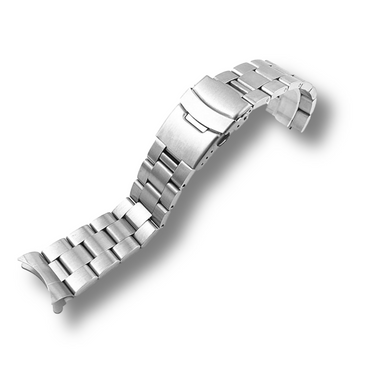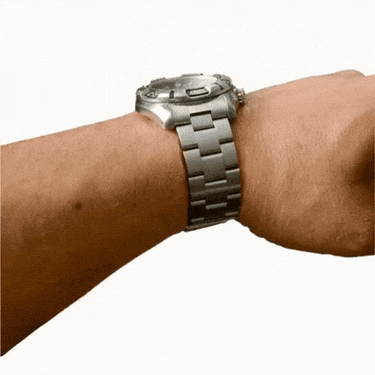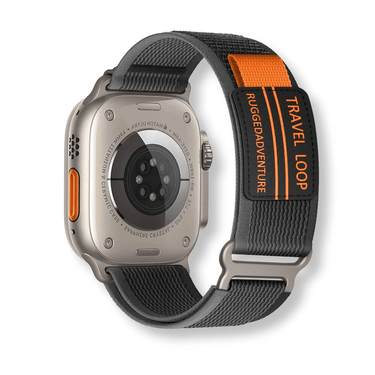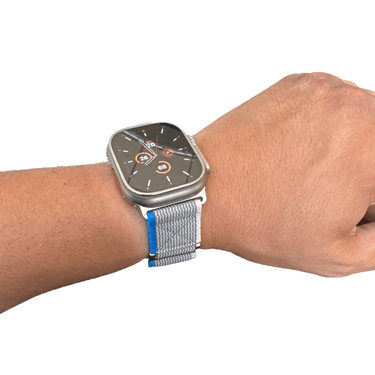Silicone watch bands have gained immense popularity in recent years, becoming a fashionable and practical choice for watch enthusiasts. These bands are made from a synthetic polymer known as silicone, which offers numerous advantages over traditional materials like leather or metal.
Silicone bands are especially popular among Apple Watch users due to their comfort and versatility. However, it is important to consider potential skin irritation risks when choosing these bands.
With its durability, flexibility, and water resistance properties, silicone has become the go-to material for active individuals and those seeking comfort in their everyday wear. However, while silicone watch bands have become increasingly prevalent, it is crucial to acknowledge the potential risks associated with wearing them.
As consumers, we often focus on the benefits without considering the possible drawbacks. Therefore, by delving into the topic of skin irritation caused by silicone watch bands, we can better understand these risks and make informed decisions about our choice of wristwear.
Brief Overview of Silicone Watch Bands and Their Popularity
Silicone watch bands are made from a type of rubber-like material called silicone elastomer or polydimethylsiloxane (PDMS). This polymer possesses exceptional properties that make it an ideal choice for manufacturing diverse products - from kitchenware to medical devices. Due to its unique characteristics such as high tensile strength and resistance to temperature extremes, silicone has found a niche in the world of fashion as well.
The popularity of silicone watch bands can be attributed to their versatility and wide range of designs available on the market. Silicone offers endless possibilities for customization with various colors, patterns, textures, and finishes.
From vibrant hues to minimalist aesthetics, there is a silicone band to suit every taste and style preference. Moreover, these bands are compatible with most watch faces due to their flexible nature.
Highlighting the Importance of Considering Potential Risks
Despite their widespread acceptance among consumers worldwide, it is important not to overlook the potential risks associated with wearing silicone watch bands. Skin irritation is one such concern that deserves attention.
While many people happily wear silicone bands without experiencing any adverse effects, others may develop allergies or sensitivity to the material. By acknowledging the potential risks, individuals can take proactive measures to prevent or mitigate skin issues caused by silicone watch bands.
Awareness empowers consumers to make informed choices regarding their wristwear and consider alternative materials if necessary. Prioritizing safety and comfort should always be at the forefront when selecting accessories that come into direct contact with our skin.
Moreover, understanding the causes and symptoms of skin irritation resulting from silicone watch bands will enable users to identify early warning signs and seek appropriate remedies. By addressing these concerns, we can strike a balance between fashion and health, ensuring that our choice of wristbands enhances both style and well-being.
In the following sections, we will delve deeper into the composition of silicone watch bands, explore the potential causes of skin irritation related to their usage, and discuss preventive strategies for mitigating these risks. By doing so, we can make informed decisions about our wristwear while keeping our skin healthy and comfortable.
Understanding Silicone Watch Bands
Silicone watch bands have gained tremendous popularity in recent years due to their remarkable properties and versatility. But before delving into the potential risks associated with wearing silicone watch bands, it is crucial to understand what exactly silicone is and why it is favored among consumers.
Definition and Composition of Silicone Material
Silicone, also known as polysiloxane, is a synthetic polymer composed of silicon atoms, oxygen atoms, carbon atoms, and hydrogen atoms. This unique chemical composition gives silicone its distinctive characteristics. The combination of inorganic silicon-oxygen bonds with organic methyl or vinyl groups creates a highly stable and flexible material.
The molecular arrangement in silicone imparts excellent heat resistance, making it suitable for use in extreme temperatures without losing its shape or integrity. Additionally, silicone exhibits low toxicity levels, ensuring its safety for various applications ranging from medical devices to kitchen utensils.
Advantages of Silicone Watch Bands
Durability is one of the primary advantages that make silicone watch bands a popular choice among consumers. Unlike traditional leather or fabric straps that can wear out over time or be easily damaged by moisture or environmental factors, silicone bands are highly durable and resilient. They can withstand daily wear and tear without showing signs of deterioration.
The flexibility of silicone further enhances its appeal as a material. It molds comfortably around the wrist, providing an ergonomic fit that minimizes discomfort during extended periods of wear.
This flexibility allows for freedom of movement without constriction or chafing. Another notable advantage is the water resistance inherent in silicone watch bands.
Whether you're swimming laps at the pool or caught in an unexpected rain shower, your timepiece remains protected against water damage when equipped with a silicone band. This feature ensures longevity while granting peace of mind for outdoor enthusiasts or individuals with active lifestyles.
Different Types of Silicone Watch Bands Available in the Market
The market offers a wide range of silicone watch bands, catering to diverse preferences and styles. Smooth silicone bands, typically made from pure silicone, provide a sleek and modern aesthetic.
They feel soft against the skin and offer a comfortable fit without any texture or pattern. For those seeking more visual interest, textured or patterned silicone bands are available.
These bands may feature embossed patterns, such as ridges or grooves, adding a touch of uniqueness to the watch's overall appearance. Furthermore, some manufacturers incorporate additional materials into their silicone watch bands to enhance durability or aesthetics.
For instance, reinforced silicone bands may have embedded fibers that increase strength and resistance to stretching. Moreover, hybrid bands combine silicone with other materials like stainless steel for an attractive combination of style and functionality.
Understanding the composition and advantages of silicone watch bands is crucial before exploring potential risks associated with their use. Silicone's unique properties contribute to its popularity, offering durability, flexibility, water resistance, and numerous options for personalization in the market.
Skin Irritation: Causes and Symptoms
Explanation of contact dermatitis and its common causes
Skin irritation is a common condition characterized by redness, itching, inflammation, or discomfort of the skin. It occurs when the skin's protective barrier becomes compromised or reacts to external stimuli. Several factors can contribute to skin irritation, including exposure to irritants or allergens, friction, moisture, and certain medical conditions.
In the case of silicone watch bands, the direct contact between the band and the skin can trigger various forms of irritation. One primary cause of skin irritation is contact dermatitis, which occurs when the skin comes into contact with substances that elicit an allergic or irritant response.
Silicone itself is generally considered non-irritating; however, some individuals may develop sensitivities or allergies to specific components present in silicone watch bands. These components can include additives used during manufacturing processes or impurities that might be present in low-quality materials.
Overview of allergic reactions to certain materials, including silicone
Allergic reactions occur when an individual's immune system overreacts to harmless substances called allergens. While silicone allergies are relatively rare compared to other materials such as metals or latex, they can still affect susceptible individuals.
The most common type of allergic reaction associated with silicone watch bands is delayed hypersensitivity reaction. In delayed hypersensitivity reactions, an initial exposure to a substance sensitizes the immune system.
Upon subsequent exposure to the same substance (in this case silicone), an immune response is triggered leading to various symptoms of allergy including rash, itching (pruritus), redness (erythema), swelling (edema), and even blisters in severe cases. It's important for individuals who experience these symptoms after wearing a silicone watch band to seek medical advice for proper diagnosis and avoid further exposure.
Symptoms experienced by individuals who develop skin irritation from wearing silicone watch bands
Individuals who develop skin irritation or allergic reactions from wearing silicone watch bands may experience a range of symptoms. These can vary in severity and presentation from person to person. Some common symptoms include localized redness and inflammation at the contact site, itchiness, a burning sensation, dry or flaky skin, and the formation of small bumps or blisters.
In more severe cases, intense itching can lead to scratching, potentially causing skin breaks and secondary infections. It is worth noting that in some instances, individuals may not experience immediate symptoms upon initial use but could develop them over time with prolonged exposure to the silicone material.
Furthermore, individuals with pre-existing dermatological conditions such as eczema or psoriasis may be more susceptible to developing skin irritation from wearing silicone watch bands. To minimize the risk of developing these symptoms, it is crucial for individuals to be aware of their sensitivity or allergies and take appropriate precautions when selecting and using silicone watch bands.
Regular monitoring of the skin's condition and discontinuation of use if any signs of irritation are observed can help prevent long-term complications. While silicone itself is generally considered safe for most people, it's essential to recognize that some individuals may experience skin irritation or allergic reactions when wearing silicone watch bands.
Understanding the causes of such reactions—whether due to specific components in the silicone material or individual sensitivities—is crucial for proper diagnosis and prevention. By being aware of potential risks and practicing good skincare habits, individuals can enjoy wearing their favorite watches without compromising their skin health.
Prolonged exposure to sweat and moisture trapped under the band
When Sweat Meets Silicone
One of the primary factors that can contribute to skin irritation when wearing silicone watch bands is prolonged exposure to sweat and moisture trapped underneath the band. While silicone is known for its water-resistant properties, it is not completely impervious to the effects of sweat.
When we engage in physical activities or experience a rise in body temperature, our bodies naturally release sweat as a means of cooling down. This perspiration can accumulate between our skin and the silicone watch band, creating a moist environment that promotes skin irritation.
The Chemical Interaction Challenge
You may wonder how something as innocuous as simple perspiration can lead to skin irritation when combined with silicone. The answer lies in the potential interaction between sweat and certain chemicals present in the silicone material. Silicone watch bands often contain various additives or colorants that enhance their appearance or functionality.
However, some individuals may have sensitivities or allergies to these added components. The chemical makeup of certain additives can trigger an inflammatory response when they come into contact with sweat on sensitive skin.
These interactions can cause redness, itching, or even rashes for those who are susceptible. It is crucial to be mindful of any personal sensitivities when considering wearing silicone watch bands for extended periods.
Bacteria Growth: A Hidden Culprit
Beyond chemical interactions, another factor contributing to skin irritation from silicone watch bands is the role bacteria growth plays in exacerbating discomfort. The moist environment created by trapped sweat provides an ideal breeding ground for bacteria proliferation on both our skin and underneath the band itself. Bacteria thrive in warm and damp conditions, leading to potential bacterial infections like folliculitis or even dermatitis if left unaddressed.
These infections often manifest as small red bumps, pus-filled blisters, or itchiness. Maintaining proper hygiene practices, such as regularly cleaning and drying both the band and the skin underneath, is crucial to prevent bacterial growth and subsequent skin irritation.
Allergic reactions triggered by specific components in silicone
Unveiling Allergenic Additives
While silicone is generally considered hypoallergenic, some individuals may experience allergic reactions due to specific additives or impurities present in the material. Silicone watch bands can contain substances like sulfur or organic peroxides, which are used during the production process but have the potential to cause sensitivities in certain individuals.
It's important to note that allergic reactions can vary in severity from mild itching or redness to more severe symptoms like hives or dermatitis. If you have a known allergy to any specific compounds found in silicone materials, it's advisable to opt for alternative watch band options that suit your needs without triggering an adverse reaction.
The Latex Connection
Cross-reactivity between latex allergies and silicones is another aspect worth considering when examining potential allergic reactions associated with silicone watch bands. Some individuals who have a latex allergy may also exhibit sensitivity towards silicones due to similar protein structures found in both materials.
If you have a known latex allergy or experience symptoms such as itching, swelling, or respiratory distress when exposed to latex products, it's crucial to approach silicone watch bands with caution. Consult with a healthcare professional if unsure about potential cross-reactivity risks and explore alternative materials that minimize allergic responses.
Tightness or improper fitting of the band
Friction: The Unwanted Consequence
Finding the perfect fit for your silicone watch band is not just about aesthetics but also plays a significant role in preventing skin irritation. Wearing a band that is too tight can create excessive friction against your skin, leading to discomfort and potentially causing skin irritation over time.
The constant rubbing and pressure on the skin's surface can disrupt its protective barrier, making it more susceptible to irritation and inflammation. It is essential to ensure a comfortable fit that allows for some movement without being overly loose or tight, striking the right balance between security and avoiding unnecessary pressure.
Choosing Comfort
Selecting an appropriate size for your silicone watch band is key to maintaining both comfort and skin health. When purchasing a band, it is advisable to measure your wrist accurately or consult the sizing guide provided by the manufacturer.
Consider factors such as band width, buckle design, and adjustability options to find a watch band that fits snugly but not too tightly. Keep in mind that everyone's wrist size can vary, so what may be comfortable for one person might not be for another.
Prioritizing comfort will go a long way in minimizing friction-related skin irritation while enjoying the benefits of wearing a silicone watch band. Understanding the potential factors contributing to skin irritation when wearing silicone watch bands allows us to make informed decisions about our wrist accessories.
Prolonged exposure to sweat and moisture trapped under the band can lead to chemical interactions and bacterial growth, aggravating discomfort. Allergies triggered by specific additives or cross-reactivity with latex allergies should also be considered.
Additionally, ensuring an appropriate fit prevents friction-related issues that can cause skin irritation over time. By balancing style with personal comfort and hygiene practices, we can enjoy our silicone watch bands responsibly while keeping our skin healthy and happy.
Prevention and Mitigation Strategies
Proper hygiene practices for maintaining clean watch bands
To minimize the risk of skin irritation, it is essential to maintain cleanliness and hygiene when wearing silicone watch bands. Regularly cleaning your watch band with mild soap and water can help remove dirt, sweat, and bacteria that may accumulate over time.
Gently scrubbing the band with a soft brush or cloth will ensure thorough cleaning without damaging the material. After cleaning, make sure to rinse the band thoroughly to remove any residue from the soap.
Guidelines for regular cleaning and drying to prevent bacterial growth
In addition to regular cleaning, proper drying is crucial in preventing bacterial growth under your silicone watch band. After washing, pat dry the band with a clean towel or let it air-dry completely before wearing it again.
Moisture trapped between the band and your skin can create an environment ideal for bacteria to thrive, leading to skin irritation. By ensuring that your watch band is dry before putting it back on, you significantly reduce this risk.
Usefulness of rotating different watch bands to allow skin
Another effective strategy in mitigating skin irritation from silicone watch bands is by rotating between different bands. Wearing the same band continuously can lead to prolonged contact with potential irritants present in the material or accumulated sweat and dirt.
By alternating between different bands, you give your skin a break from constant contact with one particular type of material. This practice allows your skin sufficient time to recover and reduces the likelihood of developing irritation due to prolonged exposure.
Managing Skin Irritation
Symptoms and Treatment
Managing skin irritation caused by silicone watch bands requires a combination of self-care practices and medical treatment. If you notice symptoms such as redness, itching, or inflammation, the first step is to remove the watch band and gently clean the affected area with mild soap and water. This helps to remove any potential irritants that may be exacerbating the condition.
Applying a topical corticosteroid cream or ointment can significantly reduce inflammation and alleviate discomfort. These over-the-counter treatments are effective in managing mild to moderate skin irritation. However, if the symptoms persist or worsen, it is crucial to consult a dermatologist. A healthcare professional can provide a proper diagnosis and recommend stronger prescription treatments if necessary. They can also help identify any underlying conditions or allergies that might be contributing to the irritation.
By taking these steps, you can effectively manage skin irritation and continue to enjoy wearing your watch without discomfort.
Alternatives to Silicone Bands
If you experience skin irritation or allergic reactions to silicone watch bands, it might be time to explore alternative materials. There are several options available that can provide both comfort and style without compromising your skin health.
Leather bands are a popular choice, especially for those with sensitive skin. They are breathable and gentle, reducing the risk of irritation. Leather bands come in various styles and colors, making them a versatile option for any occasion.
Stainless steel bands are another excellent alternative. They are durable, hypoallergenic, and add a touch of elegance to your watch. Stainless steel bands are particularly suitable for individuals who prefer a more formal look.
Fabric bands offer a lightweight and comfortable option, perfect for casual wear. They are often made from soft, breathable materials that minimize the risk of skin irritation.
When choosing an alternative watch band, ensure it is made from high-quality materials and designed for a comfortable fit. This will help you avoid allergic reactions and enjoy your watch without any discomfort.
Conclusion
Skin irritation caused by silicone watch bands is a common condition that can be managed with self-care practices and medical treatment. By understanding the causes of skin irritation, taking steps to prevent it, and exploring alternative materials, you can enjoy wearing your watch without compromising your skin health. Remember to prioritize your skin health and take proactive measures to prevent skin irritation. If you experience persistent or severe symptoms, consult a dermatologist for professional advice and treatment. By being informed and proactive, you can strike a balance between style and comfort, ensuring that your choice of wristwear enhances both your fashion sense and well-being.
While silicone watch bands offer numerous advantages such as durability and flexibility, it is important not to overlook their potential risks in terms of causing skin irritation. By understanding these risks and implementing preventive measures such as proper hygiene practices—cleaning the bands regularly using mild soap and water and ensuring thorough drying—as well as rotating between different bands, you can significantly reduce the likelihood of experiencing skin irritation.
Remember, being proactive and mindful of your skin's health can help you enjoy the benefits of silicone watch bands without any discomfort. By taking these precautions, you can confidently wear your favorite timepiece while maintaining healthy and irritation-free skin.
























